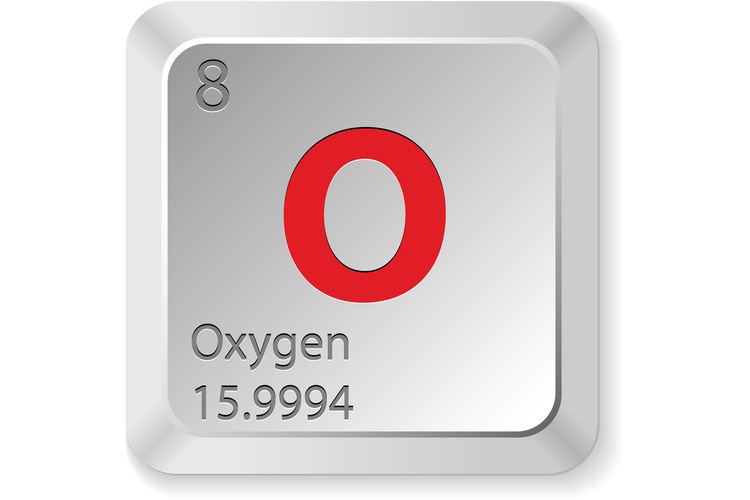Facts About Oxygen

Breathe in … breathe out. Ahh. Hooray for oxygen, the element that keeps much of life on Earth humming.
Element No. 8 on the Periodic Table of the Elements is a colorless gas that makes up 21 percent of Earth's atmosphere. Because it's all around, oxygen is easy to dismiss as dull and inert; in fact, it's the most reactive of the non-metallic elements.
Earth has been oxygenated for about 2.3 billion to 2.4 billion years, and levels began to creep up at least 2.5 billion years ago, according to a 2007 NASA-funded study. No one knows quite why this lung-friendly gas suddenly became a significant part of the atmosphere, but it's possible that geologic changes on Earth led to oxygen produced by photosynthesizing organisms sticking around, rather than being consumed in geologic reactions, according to the study researchers.
Just the Facts
- Atomic Number (number of protons in the nucleus): 8
- Atomic Symbol (on the Periodic Table of Elements): O
- Atomic Weight (average mass of the atom): 15.9994
- Density: 0.001429 grams per cubic centimeter
- Phase at Room Temperature: Gas
- Melting Point: minus 361.82 degrees Fahrenheit (minus 218.79 degrees Celsius)
- Boiling Point: minus 297.31 degrees F (minus 182.95 degrees C)
- Number of isotopes (atoms of the same element with a different number of neutrons): 11; three stable
- Most common isotopes: O-16 (99.757 percent natural abundance)
Breath of life
Oxygen is the third most abundant element in the universe, according to the Thomas Jefferson National Accelerator Facility. However, its reactivity made it relatively rare in early Earth's atmosphere.
Cyanobacteria, which are organisms that "breathe" using photosynthesis, take in carbon dioxide and exhale oxygen, just like modern plants. Cyanobacteria were likely responsible for the first oxygen on Earth, an event grandly known as the Great Oxidation Event.
Photosynthesis by cyanobacteria was likely ongoing before significant levels of oxygen built up in Earth's atmosphere; a March 2014 study published in the journal Nature Geoscience found that 2.95 billion-year-old rocks found in South Africa contained oxides that would have required free oxygen to form. These rocks were originally in shallow seas, suggesting that oxygen from photosynthesis first began to accumulate in marine environments about half a billion years before it began to accumulate in the atmosphere around 2.5 billion years ago.
Life today depends heavily on oxygen, but the initial build-up of this element in the atmosphere was nothing short of a disaster. The new atmosphere caused a mass extinction of anaerobes, which are organisms that don't require oxygen. Anaerobes that were unable to adapt or survive in the presence of oxygen died off in this new world. [Infographic: Earth's Atmosphere Top to Bottom]
Get the world’s most fascinating discoveries delivered straight to your inbox.
Fast forward — way forward. The first inkling humans had of the existence of oxygen as an element was in 1608, when Dutch inventor Cornelius Drebbel reported that the heating of saltpeter (potassium nitrate) released a gas, according to the Royal Society of Chemistry (RSC). The identity of that gas remained a mystery until the 1770s, when three chemists converged on its discovery more or less at the same time. English chemist and clergyman Joseph Priestly isolated oxygen by shining sunlight on mercuric oxide and collecting the gas from the reaction. He noted that a candle burned more brightly in this gas, according to the RSC, thanks to oxygen's role in combustion.
Priestly published his findings in 1774, beating out Swiss scientist Carl Wilhelm Steele, who had actually isolated oxygen in 1771 and written about it, but not published the work. Oxygen's third discoverer was Antoine-Laurent de Lavoisier, a French chemist who gave the element its name. The word comes from the Greek "oxy" and "genes," meaning "acid-forming."
Oxygen has eight total electrons — two orbit the nucleus in the atom's inner shell and six orbit in the outermost shell. The outermost shell can hold a total of eight electrons, which explains oxygen's tendency to react with other elements: Its outer shell is incomplete, and electrons are thus free for the taking (and giving).
Who knew?
- As a gas, oxygen is clear. But as a liquid, it's pale blue.
- If you've ever wondered what swimming in a pool of liquid oxygen would be like, the answer is: very, very cold, according to Carl Zorn of the Thomas Jefferson National Accelerator Facility. Oxygen must get down to minus 297.3 F (minus 183.0 C) to liquefy, so frostbite would be a problem.
- Too little oxygen is problematic. So is too much. Breathing 80 percent oxygen for more than 12 hours irritates the respiratory tract and can eventually cause deadly fluid build-up, or edema, according to the University of Florida and the company Air Products.
- Oxygen is one tough cookie: A 2012 study published in the journal Physical Review Letters found than an oxygen molecule (O2) can survive pressures 19 million times higher than atmospheric pressure.
- The lowest levels of oxygen ever recorded in human blood were measured near the summit of Mount Everest in 2009. Climbers had arterial oxygen levels of 3.28 kilopascals on average. Compare that to the normal value of 12 to 14 kilopascals, and the mountaineering term "death zone" makes plenty of sense. The findings were published in the New England Journal of Medicine.
- Thank goodness for an atmosphere of 21 percent oxygen. About 300 million years ago, when oxygen levels reached 35 percent, insects were able to grow super-large: Think dragonflies with the wingspans of hawks.
Current research
Oxygen forms in the hearts of stars, with the fusion of a carbon-12 nucleus and a helium-4 nucleus (also known as an alpha particle). It's only recently, however, that scientists have been able to peer into the nucleus of oxygen and unravel its structure.
In March 2014, North Carolina State University physicist Dean Lee and his colleagues reported that they'd figured out the nuclear structure of oxygen-16, the most common isotope of oxygen, in its ground state (the state at which all electrons are at the lowest possible energy levels) and in its first excited state (the next energy level up).
Why should such a thing matter? Well, to understand how nuclei form in stars — from carbon to oxygen to heavier elements — is to understand how the very building blocks of the universe snap together. Lee and his team originally discovered that the nucleus of a carbon-12 molecule, with its six protons and six neutrons, is actually made of three particle clusters, each with two protons and two neutrons. If carbon-12 had three of these so-called alpha clusters, the researchers reasoned, oxygen-16 was likely to have four, given that it has eight protons and eight neutrons.
Using supercomputer simulations and a numerical lattice, the researchers were able to see how the particles in an oxygen-16 nucleus would arrange themselves. They found that in the ground state of oxygen-16, there are indeed four alpha clusters, arranged neatly in a tetrahedron.
"These alpha clusters are sort of like little fuzzy spheres of these four particles, or these nucleons, and these fuzzy spheres like to touch each other by some surface interaction," Lee told Live Science. The tetrahedron configuration allows them to get nice and snug.
But there was another quantum mystery waiting to be unraveled. The ground state of oxygen-16 and the first excited state share an unusual feature. They both have the same spin — a value indicating how the particles rotate. They also both have positive parity, a way to indicate symmetry. Imagine inverting left and right in the entire universe, but having to keep subatomic particles in the same shape. Particles with positive parity would be able to look in this mirror universe and see themselves as they are. Particles with negative parity would have to flip-flop, lest they end up backwards like a line of text read in a mirror.
"The mystery was why the lowest two states of oxygen-16 have zero spin and positive parity," Lee said, given that the states are different.
The simulations gave an answer: In its excited state, oxygen-16 rearranges its nucleus to look little like the ground state at all. Instead of a tetrahedral arrangement, the alpha particles arrange themselves in a square or near-square plane.
"Their underlying intrinsic structures were different," Lee said. The totally different configuration explains how spin and parity could remain the same — the nuclei take different paths to the same result.
There are still more quantum interactions in the oxygen-16 nucleus to detangle, Lee said, and finer-grained detail to discover.
"There are actually quite a lot of interesting things going inside of little things like nuclei," he said. "And there are stories that are being told about how they are being made that we are now starting to be able to address."
Lee's work looks to oxygen's birth in the stars; another line of oxygen research focuses on the element's role in life on Earth. Shortly after the Great Oxidation Event some 2.4 billion years ago, oxygen levels may have reached or exceeded today's levels before crashing, said Daniel Mills, a doctoral candidate at the Nordic Center for Earth Evolution at the University of Southern Denmark. Animal life didn't show up until far later, with the simplest animals appearing around 600 million years ago.
Despite theories that the rise of oxygen paved the way for the existence of animals, the story appears to be far more complex. Animals did not appear during the first significant bump in Earth's oxygen levels 2.4 billion years ago. And in February 2014, Mills and his colleagues reported in the journal PNAS that modern-day sponges can still breathe, eat and even grow in oxygen levels 0.5 percent to 4 percent of what is found in Earth's atmosphere today. Sponges are the probably the most similar living animal to the first animals on Earth, Mills told Live Science.
The finding that sponges don't need high oxygen to live suggests that something else contributed to the rise of the first animal life — though rising oxygen may well have been necessary to reach the kind of diversity and ecosystems we see today, Mills said. Even in the modern era, animals such as nematode worms thrive in low-oxygen areas of the ocean, he added.
"There is clearly more to animal evolution than an ample supply of oxygen," Mills said.
Additional resources
- An interactive graphic created by the Howard Hughes Medical Institute also shows the geologic history of oxygen, beginning about 3.8 billion years ago.
- Learn more about what makes up Earth's atmosphere today, all about air pressure and volume, and weather at this kids site by the National Center for Atmospheric Research.
Follow Live Science @livescience, Facebook & Google+.

Stephanie Pappas is a contributing writer for Live Science, covering topics ranging from geoscience to archaeology to the human brain and behavior. She was previously a senior writer for Live Science but is now a freelancer based in Denver, Colorado, and regularly contributes to Scientific American and The Monitor, the monthly magazine of the American Psychological Association. Stephanie received a bachelor's degree in psychology from the University of South Carolina and a graduate certificate in science communication from the University of California, Santa Cruz.


